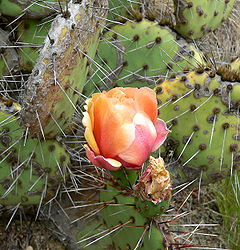Opuntia phaeacantha
| Opuntia phaeacantha subsp. var. | tulip prickly pear, desert prickly pear | |||||||||||||||||||||||||||||||||||||||||||||||||||||||
|---|---|---|---|---|---|---|---|---|---|---|---|---|---|---|---|---|---|---|---|---|---|---|---|---|---|---|---|---|---|---|---|---|---|---|---|---|---|---|---|---|---|---|---|---|---|---|---|---|---|---|---|---|---|---|---|---|

|
|
| ||||||||||||||||||||||||||||||||||||||||||||||||||||||
| ||||||||||||||||||||||||||||||||||||||||||||||||||||||||
Opuntia phaeacantha is a species of prickly pear cactus known by the common names tulip prickly pear and desert prickly pear.
It is found across the southwestern United States and northern Mexico. It has a characteristic prickly pear appearance, with flattened green pads bearing wool and spines. The spines are brown, reddish-brown, or gray, and often over 3 centimeters in length. The flowers are usually bright yellow with reddish centers, and sometimes peach, pinkish or reddish overall. The edible fruits are red or purple with green flesh. The pads and fruit bear tiny glochids which can lodge in the skin and cause irritation. The plant forms dense but localized thickets. There are several varieties of this particular species, and it also hybridizes easily with other prickly pears, making identification sometimes tricky.
Older names for this species, and names for old species which are now considered variants of this species, include plateau prickly pear, brown-spined prickly pear, Mojave prickly pear, and Kingman prickly pear.
This plant, like other Opuntia species, is attacked by cactus moth.
| Standard Cyclopedia of Horticulture |
|---|
|
Opuntia phaeacantha, Engelm. A diffuse, semi-prostrate, plant. 1-2 ft. high, and freely rooting from lower margin of joints: joints broadly obovate, moderately thick. 4-6 in. long: areoles about 1 in. apart, with short wool and reddish or brownish bristles; spines mostly toward margin or on apex of joints, 2-5. straight and stiff, reddish brown to almost black with lighter tips, 1-2½ in. long: fls. 2½ in. broad, yellow: fr. usually long- pyriform, 1 in. or less diam. and twice as long, purple, with greenish acid pulp. S. W. U. S. and Mex. Var. major, Hort., is a good form.—This species and a number of the following become deep purplish green during autumn and winter. In the spring they lose their purplish color to a large extent and take it on again in the fall. The spines are also much darker in winter than in summer.
|
Cultivation
Propagation
Pests and diseases
Varieties
Gallery
References
- Standard Cyclopedia of Horticulture, by L. H. Bailey, MacMillan Co., 1963
External links
- w:Opuntia phaeacantha. Some of the material on this page may be from Wikipedia, under the Creative Commons license.
- Opuntia phaeacantha QR Code (Size 50, 100, 200, 500)
